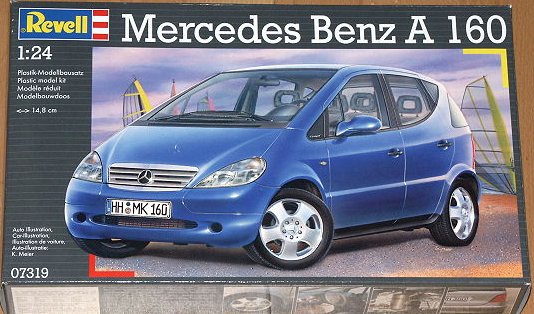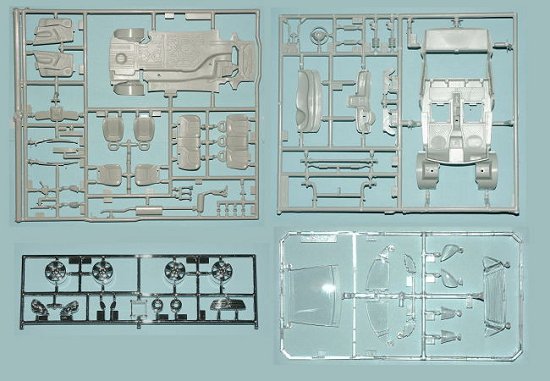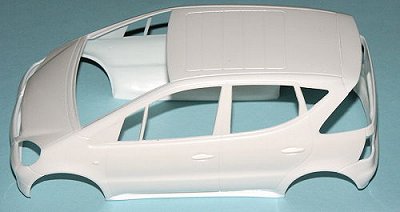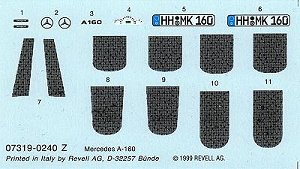
|
KIT: |
Revell 1/24 Mercedes A 160 |
|
KIT # |
07319 |
|
PRICE: |
€ 15.00 |
|
DECALS: |
One option |
|
REVIEWER: |
Martin Sczepan |
|
NOTES: |

|
HISTORY |
For a long time the automobile market in Germany had been divided between the six big German car companies which each of the companies having their own market segment - Volkswagen and Opel (a German GM division) for the smaller and mass market cars, BMW and Audi for the ‘upper middle class’, Mercedes-Benz for the luxury market and Porsche for sports cars. There was always some degree of overlap but things really started to change in the second half of the nineties. By now everything has mixed up and you can buy a luxury sedan from Volkswagen (the Phaeton), a small car from BMW (the MINI and soon there will be a '1-series') or even a SUV from Porsche...
One of the pioneers in this policy of trying to get a foot into new market segments is Mercedes-Benz. Within the last ten years the company extended its lineup into the small car, SUV and the super luxury class. Actually the smallest (the ‘smart’) as well as the largest (the Maybach 62) German series production cars are built by Daimler-Chrysler companies, although for marketing reasons these cars are not sold under the Mercedes brand. Well, the ‘smart’ is not really German, being produced in France and not even a car by American standards... But that’s another story - and another Revell kit.
But back to our subject. The first step for Mercedes was to enter the most important car class in central and western Europe - the ‘compact class’. Also named the ‘Golf’-class in Germany - after the VW Golf - which is (now in its fifth incarnation) the best selling car in Germany for more than two decades... Mercedes engineers and marketing people soon realized that building just another Golf/Megane/Civic/Corolla would not do the job and went on to create a car which would establish it’s own class somewhere between small station wagons and small van - the ‘compact van’. Having similar external dimensions (except for height) as a normal compact car, the higher body and intelligent arrangement of engine and transmission components allow for a roomy ‘van-like’ interior with higher seat positions. This concept proved to be successful - as can be seen by the fact that many companies offer similar cars these days - from the Audi A2 (which is conceptually very similar) to the Volkswagen Touran, the Renault Scenic or the Honda Jazz which are somewhat larger and based on the companies compact models. Since the car was the smallest Mercedes it got the designation ‘A-Klasse’ with the C-class being the next larger model.
Mercedes’ announcement of the new car created quite a craze - after all the company was attacking Volkswagen, Opel and Ford on their very own territory. The expectations on the car were quite high when the car became available in fall 1997. Unfortunately for the company, the first series of cars had some teething problems. In a special test (dubbed the ‘Elchtest’ i.e. ‘moose test’) at about 60 kph / 45 miles trying to avoid an animal suddenly crossing the road Swedish motor journalists managed to flip over the car. This happened only under special conditions - when the car was loaded with four persons and only with one specific type of tires but the effect was reproducible. The pictures of the car literally jumping off the road marred the reputation of the car and caused a lot of ‘Schadenfreude’ with half of Germany making jokes about the new Mercedes and the problems a big company had with building a small car. The company had to react and halted production and recalled the cars already sold. After some months pause the production of the ‘new’ A-class resumed in spring 1998. Changes included lowered suspension and wider tyres. Additionally all cars were equipped with an ESP (electronic stability program) which until then could only be found in luxury cars. Nowadays you can find such systems (each company has a different name for this but it’s basically the same) in most new cars - at least here in Europe but in 1998 it was quite groundbreaking. With these changes and big marketing and advertising efforts Mercedes managed to make the A-Class a very successful model. The ‘Elchtest’ debacle is almost forgotten now and the car is still in production with its second generation already on the horizon (summer 2004). The car is offered with different gas and diesel engines and in three design lines: ‘classic’ (the basic) ‘elegance’ (the luxurious/conservative) and ‘avantgarde’ (the luxurious/modern). Since 2001 also a longer wheel base version is available. I guess it’s time to conquer the American market now...
|
THE KIT |

 The Revell kit
represents a 1998 A 160 ‘avantgarde’ model with sunroof. Since the
external appearance of the car didn’t change much in the last years
except for headlight and taillight configurations it should be no big
problem to convert it into a newer model. It comes in one of the typical
side opening cardboard boxes Revell uses these days. The box is somewhat
flimsy and to large for the model of such a small car. It contains the
car body in white plastic, two light gray, one clear and one chrome
plated sprues and four vinyl tyres (sorry these are missing in the
photos) - all in all about 65 parts. A small decal sheet contains
instruments, external decorations, German license plates (for a car
registered in Hamburg) and decoration for the seat cover materials. The
molding quality is good although some details are somewhat soft and the
gray parts show some flash. The clear parts are nicely done but most of
the chrome plated parts are somewhat soft in detail and of questionable
use. The wheel rims on the original are not chrome plated but light metal
alloy and therefore have to be painted anyway.
The Revell kit
represents a 1998 A 160 ‘avantgarde’ model with sunroof. Since the
external appearance of the car didn’t change much in the last years
except for headlight and taillight configurations it should be no big
problem to convert it into a newer model. It comes in one of the typical
side opening cardboard boxes Revell uses these days. The box is somewhat
flimsy and to large for the model of such a small car. It contains the
car body in white plastic, two light gray, one clear and one chrome
plated sprues and four vinyl tyres (sorry these are missing in the
photos) - all in all about 65 parts. A small decal sheet contains
instruments, external decorations, German license plates (for a car
registered in Hamburg) and decoration for the seat cover materials. The
molding quality is good although some details are somewhat soft and the
gray parts show some flash. The clear parts are nicely done but most of
the chrome plated parts are somewhat soft in detail and of questionable
use. The wheel rims on the original are not chrome plated but light metal
alloy and therefore have to be painted anyway.
 The kit itself is a
curbside type of kit - so no engine is provided. Otherwise detailing is
nice with suspension components, brake disks and a nicely detailed
interior. This will be a fairly easy and fast build. Dry fitting revealed
that the fit seems to be good with one exception. The clear parts for the
rear windows have the correct size and shape but unfortunately not the
right curvature. It will be quite a challenge to bring them to confirm
with the body - without marring clear parts or already painted body with
glue. The instruction sheet is typical Revell with first pages giving
safety and general construction remarks in at least twenty languages,
then a sprue layout plan and then construction sequence broken down into
fifteen steps. Painting instructions are given for Revell/Germany paints
(what else...). Only one paint scheme is given (dark metallic blue) but
it’s probably not a big problem to find color information at your nearest
Mercedes dealership or at the Mercedes-Benz web site (at least for the
actual models).
The kit itself is a
curbside type of kit - so no engine is provided. Otherwise detailing is
nice with suspension components, brake disks and a nicely detailed
interior. This will be a fairly easy and fast build. Dry fitting revealed
that the fit seems to be good with one exception. The clear parts for the
rear windows have the correct size and shape but unfortunately not the
right curvature. It will be quite a challenge to bring them to confirm
with the body - without marring clear parts or already painted body with
glue. The instruction sheet is typical Revell with first pages giving
safety and general construction remarks in at least twenty languages,
then a sprue layout plan and then construction sequence broken down into
fifteen steps. Painting instructions are given for Revell/Germany paints
(what else...). Only one paint scheme is given (dark metallic blue) but
it’s probably not a big problem to find color information at your nearest
Mercedes dealership or at the Mercedes-Benz web site (at least for the
actual models).
|
CONCLUSIONS |
It’s nice that some companies make models of ‘everyday cars’. Not the Ferrari or Porsche you will probably never own anyway, but the Mercedes A-Klasse, Volkswagen Golf or some of the other cars you see every day on the streets. And - except for the poor fitting clear parts - this will be a fairly easy build resulting in a nice and unusual model of an important car.
Thanks to the EPMC Dresden and Revell Germany for the review sample.
If you would like your product reviewed fairly and quickly by a site that has nearly 250,000 visitors a month, please contact me or see other details in the Note to Contributors.